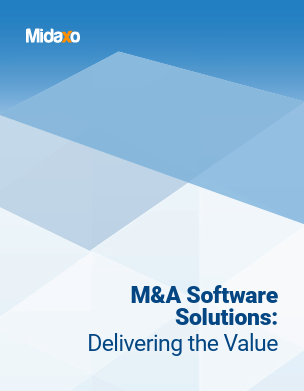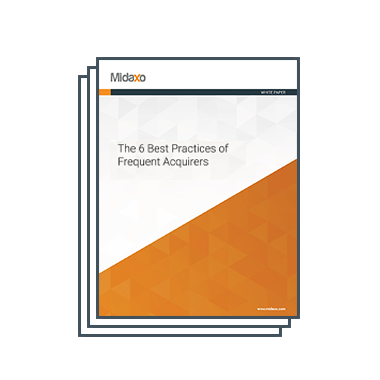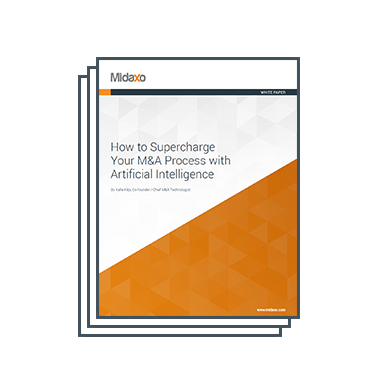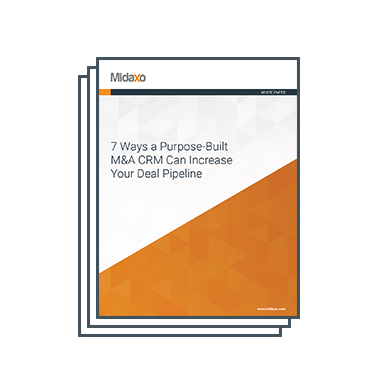During our recent live Q&A—The Future of M&A and Process Excellence—we heard from deal professionals across the industry all navigating the same challenge: how to you drive repeatability, efficiency, and clarity across a complex deal process?
With Charles Cautley, Chief Product Officer at Midaxo, leading the conversation, the session covered everything from the shortcomings of traditional tools, to how the best M&A teams are embracing process excellence, to the growing role of AI and automation in M&A. And our audience brought the questions—insightful, practical, and laser-focused on what it takes to execute better.
As a follow-up, we’re highlighting a few of the top audience questions, and Charles’ take on where the industry is heading. Whether you attended live or are catching up now, consider this a cheat sheet to the conversation around process excellence.
What is process excellence in M&A?
Recognizing a more competitive environment, and a significant opportunity to embrace new technologies, the best M&A teams are looking to breakout to much higher levels of performance by embracing strategies…
- For continually improving business processes to maximize efficiency, effectiveness, and quality.
- That include smooth, automated, consistent workflows.
- That deliver a competitive advantage and drive growth.
The four pillars to process excellence are people, process, technology & data. Like any new technology introduction, such as AI, fixing the process comes first.
What kind of deal volume justifies investing in process optimization through new technologies like automation and AI?
It depends on deal volume, average deal complexity/risk, and competitive environment. Charles offered a practical rule of thumb:
- 1–2 Deals/Year: For lower volumes, investment is still justifiable if the deals are large or highly complex (e.g., multinational integrations, high compliance risk).
- 3–4 Deals/Year: This is where repeatability starts to pay off, particularly if risks & complexity are above average.Higher automation quickly shows a substantial ROI.
- 5+ Deals/Year: Process optimization becomes essential, not optional. The benefits far exceed the investment costs of applying process excellence.
Commitment to scaling your M&A practice justifies the investment in process excellence tools. Better systems mean higher speed, lower errors, and higher deal success.
How do you embed flexibility into standardized processes, especially when every deal is different?
According to Charles, the answer is balance and process (or tool) flexibility:
- Be ambitious. It’s ok to be ambitious in standardizing a best-practice process, particularly since the team can be consistent in their approach in most cases (see bullet below).
- Standardize what’s repeatable—e.g., due diligence checklists, risk assessments, reporting templates.
- Allow for variation where it matters—deal size, geography, industry, and culture.
- Track and learn. Choose a software platform that keeps project history, understands performance and success, and makes learnings easily available to other team members.
The goal is to make the default path easy—but not the only path. Process excellence, when done right, enables better judgment.
What’s holding back widespread adoption of M&A software?
Why does M&A still rely so much on a largely Excel-based, manual, fragmented process that overlooks waste and high failure rates? A live poll during the session confirmed the following as top concerns about today’s M&A software solutions.
- Manual Workflows Still Dominate: While enthusiasm for data and platforms is high, many solutions remain overly manual, limiting the value they deliver and creating friction for end users.
- Top-Down Mandates vs. Natural Adoption: Adoption often requires heavy mandates from sellers, M&A leads, or integration managers.
- Teams are Slave to the System of Record: Value is tied too much to data entry. The path to value should be easier.
- Lack of Interoperability: Many systems act like “black boxes,” siloed and disconnected from adjacent platforms. The inability to share data fluidly across tools is a recurring pain point.
A lot of deals fail for culture reasons—but culture’s hard to define, let alone fix. How can process excellence and technology help?
It’s no secret that culture challenges derail a significant percentage of deals. Yet culture is notoriously hard to define, measure, and manage. This is where structured processes and smart platforms can help close the gap:
- Visibility leads to accountability: When cultural risks and integration steps are explicitly tracked, they’re far less likely to be ignored.
- Data enables early detection: With structured reporting and team feedback loops, you can surface friction points before they become full-blown issues.
- Repeatability offers stability: Your best practices (e.g., playbooks) hold the actions which should be followed to address culture. These best practices can be adapted quickly when new learnings are found. For example, standardized onboarding and communications help reduce confusion and create a more consistent experience for acquired teams.
Culture won’t be solved by software—but it can absolutely be supported by good process.
What’s next for M&A platforms—and how does AI fit in?
Charles explained that we are at a new frontier of technology opportunities which will offer M&A team the new era “intelligent workflow automation”. The technology opportunities include:
- Maturing AI. AI has the potential to be a big game changer for the M&A process and AI uses-cases are maturing.
- Data Access. Access to data quality and scope is increasing and this data is the foundation to offer rich, timely intelligence.
- Integrations and Interoperability. M&A teams can choose their preferred M&A platforms and ecosystem and expect workflows and dataflows to be automated easily across their end-to-end process.
Intelligent workflow automation is transforming how M&A teams operate—delivering end-to-end, intuitive processes that combine high levels of automation and predictive insights. These next-gen platforms don’t just store data; they actively guide teams through every phase of the deal with data-driven suggestions, predictive intelligence, and seamless integration across tools and systems.
Answers to an audience poll during the session emphasized the value of automation for speed and seamless end-to-end workflows, underlining the appetite in the community for these smarter, more connected systems. With that in mind, bottom-up adoption is the goal. The future of M&A tech is about systems that are intuitive and helpful for every team member, not just leadership.
How is AI maturing and helping M&A teams?
While most of its potential is still ahead of us, we know AI will help with automating more work, providing more intelligence, tailoring technology to the user, and speeding up processes. Charles pointed to several fast-maturing use cases:
- Deal Sourcing & Screening: AI can recommend potential targets based on historical patterns or strategic fit criteria.
- Faster Diligence Through Document Intelligence: AI can scan, extract, and flag critical details in diligence documents—saving hours and reducing oversight risks.
- Project Intelligence: Tools like Midaxo’s AI assistant can answer contextual project questions—e.g., “What are the top risks on this integration?” or “What is the best next step for this project” or “What action items do I currently have?”—instead of you needing to dig through the details.
- Smarter Documentation: From extracting deal details to generating board-ready summaries, AI is helping teams produce better documentation faster.
While use cases like synergy tracking with AI remain more aspirational than proven, the trend is clear: AI will continue to push the boundaries of what’s possible in M&A execution.
Final Thoughts: Driving Toward Process Excellence in M&A
The message from the webinar was clear— ambitious M&A team are no longer tolerating the status-quo of high deal failure rates. They’re embracing process excellence by:
- Driving a shift in mindset to adopt continuous improvement,
- Standardizing workflows for repeatability and optimization,
- Embracing technology platforms that don’t just deliver on the benefits of “intelligent workflow automation,” but also drive needed change.
Indeed, the best M&A platforms don’t just enforce best practice—they enable it through access to new technology opportunities, workflows with on-going learning, and real-time data. And with AI, interoperability, and user-first design evolving rapidly, there’s never been a better time to raise the bar on how deals get done.





